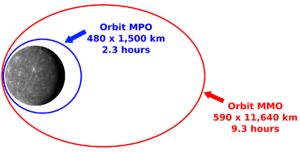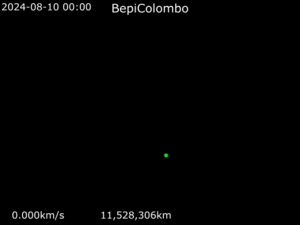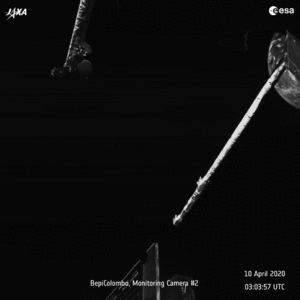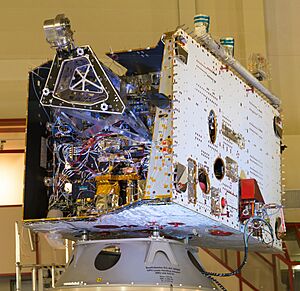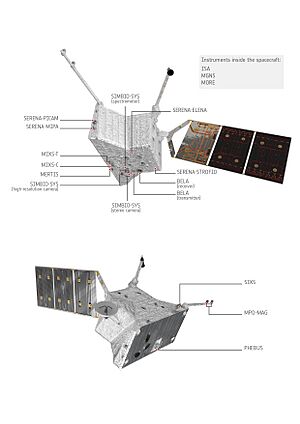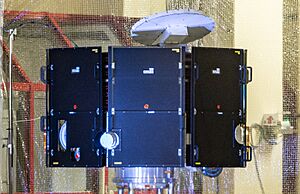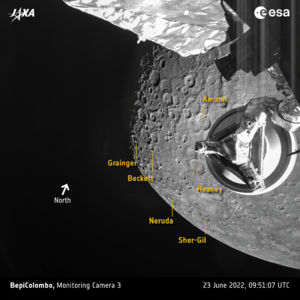BepiColombo facts for kids
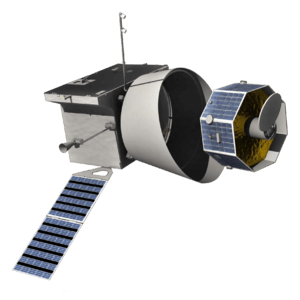
Artist's depiction of the BepiColombo mission, with the Mercury Planetary Orbiter (left) and Mercury Magnetospheric Orbiter (right)
|
|
| Mission type | Planetary science |
|---|---|
| Operator | |
| Mission duration | Cruise: 7 years (planned) 8 years (actual) Science phase: 1 year (planned) 7 years, 2 months and 10 days (in progress) |
| Spacecraft properties | |
| Manufacturer | |
| Launch mass | 4,100 kg (9,000 lb) |
| BOL mass | MPO: 1,230 kg (2,710 lb) Mio: 255 kg (562 lb) |
| Dry mass | 2,700 kg (6,000 lb) |
| Dimensions | MPO: 2.4 m × 2.2 m × 1.7 m (7 ft 10 in × 7 ft 3 in × 5 ft 7 in) Mio: 1.8 m × 1.1 m (5 ft 11 in × 3 ft 7 in) |
| Power | MPO: 150 watts Mio: 90 watts |
| Start of mission | |
| Launch date | 20 October 2018, 01:45 UTC |
| Rocket | Ariane 5 ECA (VA245) |
| Launch site | Centre Spatial Guyanais, ELA-3 |
| Contractor | Arianespace |
| Flyby of Earth (gravity assist) | |
| Closest approach | 10 April 2020, 04:25 UTC |
| Distance | 12,677 km (7,877 mi) |
| Flyby of Venus (gravity assist) | |
| Closest approach | 15 October 2020, 03:58 UTC |
| Distance | 10,720 km (6,660 mi) |
| Flyby of Venus (gravity assist) | |
| Closest approach | 10 August 2021, 13:51 UTC |
| Distance | 552 km (343 mi) |
| Flyby of Mercury (gravity assist) | |
| Closest approach | 1 October 2021, 23:34:41 UTC |
| Distance | 199 km (124 mi) |
| Flyby of Mercury (gravity assist) | |
| Closest approach | 23 June 2022, 09:44 UTC |
| Distance | 200 km (124.3 mi) |
| Flyby of Mercury (gravity assist) | |
| Closest approach | 19 June 2023, 19:34 UTC |
| Distance | 236 km (147 mi) |
| Flyby of Mercury (gravity assist) | |
| Closest approach | 4 September 2024, 21:48 UTC |
| Distance | 165 km (103 mi) |
| Flyby of Mercury (gravity assist) | |
| Closest approach | 1 December 2024, 14:23 UTC |
| Distance | 37,626 km (23,380 mi) |
| Flyby of Mercury (gravity assist) | |
| Closest approach | 8 January 2025, 05:59 UTC |
| Distance | 295 km (183 mi) |
| Mercury orbiter | |
| Spacecraft component | Mercury Planetary Orbiter (MPO) |
| Orbital insertion | November 2026 (planned) |
| Orbit parameters | |
| Perihermion | 480 km (300 mi) |
| Apohermion | 1,500 km (930 mi) |
| Inclination | 90,0° |
| Mercury orbiter | |
| Spacecraft component | Mercury Magnetospheric Orbiter (MMO) |
| Orbital insertion | November 2026 (planned) |
| Orbit parameters | |
| Perihermion | 590 km (370 mi) |
| Apohermion | 11,640 km (7,230 mi) |
| Inclination | 90.0° |
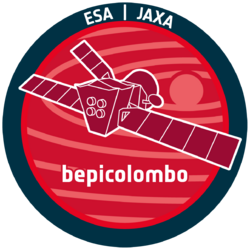 BepiColombo insignia |
|
BepiColombo is a space mission that travels to the planet Mercury. It is a joint project by the European Space Agency (ESA) and the Japan Aerospace Exploration Agency (JAXA). The mission includes two main parts: the Mercury Planetary Orbiter (MPO) and Mio (also called the Mercury Magnetospheric Orbiter, or MMO).
These two spacecraft were launched together on an Ariane 5 rocket on 20 October 2018. Their goal is to study Mercury in detail. They will look at its magnetic field, the area around it affected by its magnetic field (called the magnetosphere), and its inside and surface. The mission is expected to arrive at Mercury in November 2026. To get there, it has flown past Earth once, Venus twice, and has completed six flybys of Mercury.
In May 2024, ESA reported a small problem with the spacecraft's thrusters. This meant the thrusters could not work at full power. To fix this, the mission team changed the path of the spacecraft. This change added about 11 months to the journey. So, the arrival date at Mercury moved from December 2025 to November 2026.
What's in a Name?
The BepiColombo mission is named after Giuseppe "Bepi" Colombo. He was a smart scientist, mathematician, and engineer from Italy. Bepi Colombo came up with the idea of using a planet's gravity to help a spacecraft speed up or change direction. This trick is called a gravity assist. It was first used by the Mariner 10 mission in 1974 and is now very common for space probes.
The name Mio for the Mercury Magnetospheric Orbiter was chosen by people in Japan. In Japanese, Mio means a waterway. JAXA says this name shows how far they have come in space research. It also wishes the spacecraft a safe journey. They imagine the spacecraft traveling through the solar wind like a ship sailing on the ocean. In some Asian languages, Mercury is known as the "water star."
The Mission's Journey
The BepiColombo mission has three main parts that travel together. When they reach Mercury, two of these parts will separate to become independent spacecraft.
- Mercury Transfer Module (MTM): This part helps the spacecraft travel through space. ESA built it.
- Mercury Planetary Orbiter (MPO): This is one of the science spacecraft. ESA also built it.
- Mercury Magnetospheric Orbiter (MMO) or Mio: This is the other science spacecraft. JAXA built it.
During the launch and the long trip, these three parts are connected. They form what is called the Mercury Cruise System (MCS).
Airbus Defence and Space is the main company that built the ESA parts of the mission. ESA is in charge of the whole mission. They designed and built the MTM and MPO. The two orbiters were launched together on 20 October 2018. The launch happened from Europe’s Spaceport in Kourou, French Guiana.
The spacecraft is on an eight-year journey to Mercury. It uses special ion thrusters and gets help from the gravity of Earth, Venus, and Mercury itself. ESA's ground station in Cebreros, Spain, is the main place for talking to the spacecraft.
The Mio and MPO satellites are expected to arrive in Mercury's orbit in November 2026. They will then separate and study Mercury together for at least one year. The spacecraft have scientific tools from different countries in Europe and Japan. These tools will help them learn about Mercury's inside, its magnetic field, and its thin atmosphere.
Mercury is a small and hot planet. Its gravity is not strong enough to hold onto a thick atmosphere. Instead, it has a very thin "exosphere" made of gases like hydrogen, helium, and oxygen. This exosphere is always changing, with atoms being lost and new ones appearing. The mission will study how this exosphere works.
Mission Goals
The main goals of the BepiColombo mission are:
- To learn how a planet close to its star forms and changes over time.
- To study Mercury's shape, inside, structure, and surface features like craters.
- To explore Mercury's thin atmosphere (exosphere) and how it changes.
- To study Mercury's magnetic bubble (magnetosphere) and how it works.
- To find out where Mercury's magnetic field comes from.
- To test Einstein's theory of general relativity with great accuracy.
How the Spacecraft Travels
The stacked spacecraft will take eight years to reach Mercury's orbit. During this time, it uses solar-electric propulsion and nine gravity assists. It flew past Earth in April 2020, Venus in 2020 and 2021, and has completed six flybys of Mercury between 2021 and 2025.
The spacecraft left Earth very fast. It first orbited the Sun similar to Earth. After a while, it came back to Earth for a gravity assist. This pushed it towards Venus. Two more flybys of Venus helped it get closer to the Sun, almost to Mercury's distance, without using much fuel. Six flybys of Mercury then slowed it down. After the fourth Mercury flyby, the spacecraft was in an orbit similar to Mercury's.
Finally, special engine burns will slow the spacecraft down enough for Mercury's gravity to "capture" it in November 2026. It will then enter a polar orbit around Mercury. After this, the two orbiters will separate and use their own small engines to get into their final science orbits.
Mission Timeline
Here is the schedule for the BepiColombo mission:
| Date | Event | Comment |
|---|---|---|
| 20 October 2018, 01:45 UTC | Launch | The mission began its journey to Mercury. |
| 10 April 2020, 04:25 UTC |
Earth flyby | This happened 1.5 years after launch. |
| 15 October 2020, 03:58 UTC | First Venus flyby | The spacecraft successfully flew past Venus. |
| 10 August 2021, 13:51 UTC |
Second Venus flyby | This flyby was also successful. BepiColombo came within 552 kilometres (343 mi) of Venus. |
| 1 October 2021, 23:34:41 UTC |
First Mercury flyby | The spacecraft passed 199 kilometres (124 mi) from Mercury's surface. |
| 23 June 2022, 09:44 UTC |
Second Mercury flyby | The closest approach was about 200 kilometres (120 mi) above Mercury. |
| 19 June 2023, 19:34 UTC |
Third Mercury flyby | The closest approach was about 236 kilometres (147 mi) above Mercury. |
| 4 September 2024, 21:48 UTC | Fourth Mercury flyby | The closest approach was about 165 kilometres (103 mi) above Mercury. |
| 1 December 2024, 14:23 UTC | Fifth Mercury flyby | The closest approach was about 37,626 kilometres (23,380 mi) above Mercury. |
| 8 January 2025, 05:58:52 UTC | Sixth Mercury flyby | The closest approach was about 295 kilometres (183 mi) above Mercury. |
| November 2026 | Mercury orbit insertion | The spacecraft will separate into its two main parts. |
| 2027 | MPO in final science orbit | The Mercury Planetary Orbiter will be in its main orbit for science. |
| April 2028 | End of nominal mission | The planned end of the main mission. |
| April 2029 | End of extended mission | If the mission is extended, it will end around this time. |
Spacecraft Parts
Mercury Transfer Module
The Mercury Transfer Module (MTM) weighs about 2,615 kg (5,765 lb). It carries 1,400 kg (3,100 lb) of xenon fuel. Its job is to transport the two science orbiters to Mercury and support them during the long trip.
The MTM uses a special solar electric propulsion system. It has four ion thrusters that can work alone or in pairs. These thrusters are very powerful for their type. The MTM gets its electricity from two long solar panels, each 14-metre-long (46 ft). These panels generate enough power for the thrusters and the other spacecraft parts.
Ion thrusters work by gently pushing the spacecraft over a long time. This means the journey has many months of slow braking, with help from planetary gravity assists. Just before reaching Mercury's orbit, the MTM will be released. After that, the MPO will power Mio until Mio is in its own orbit.
Mercury Planetary Orbiter
The Mercury Planetary Orbiter (MPO) weighs about 1,150 kg (2,540 lb). It has a single solar array that can provide up to 1000 watts of power. This solar array also has special mirrors to keep its temperature below 200 °C (392 °F). The array constantly turns to keep the Sun at a good angle. This helps it make enough power while also staying cool.
The MPO carries 11 scientific tools. These include cameras to take pictures, spectrometers to analyze light (like infrared, ultraviolet, X-ray, and gamma ray), a radiometer to measure heat, a laser altimeter to measure height, and a magnetometer to measure magnetic fields. It also has tools to study tiny particles. These tools are placed on the side of the spacecraft that faces Mercury to keep them cool.
A special antenna, 1.0 m (3 ft 3 in) wide, is on a short arm. This antenna can handle high temperatures. It sends and receives information using X-band and Ka-band radio waves. The data rate is about 50 kbit/s, sending a lot of information back to Earth each year. ESA's ground station in Cebreros, Spain, is the main place for communicating with the MPO.
MPO's Science Tools
The Mercury Planetary Orbiter has eleven science tools:
- BepiColombo Laser Altimeter (BELA): This tool uses lasers to measure the height of Mercury's surface.
- Italian Spring Accelerometer (ISA): This measures how the spacecraft moves and feels forces.
- Mercury Magnetometer (MPO-MAG, MERMAG): This measures Mercury's magnetic field.
- Mercury Radiometer and Thermal Infrared Spectrometer (MERTIS): This studies the heat coming from Mercury and its surface materials.
- Mercury Gamma-ray and Neutron Spectrometer (MGNS): This looks for elements on Mercury's surface, like water ice.
- Mercury Imaging X-ray Spectrometer (MIXS): This uses X-rays to figure out what Mercury's surface is made of.
- Mercury Orbiter Radio-science Experiment (MORE): This uses radio signals to study Mercury's gravity and inside.
- Probing of Hermean Exosphere by Ultraviolet Spectroscopy (PHEBUS): This studies Mercury's thin atmosphere using ultraviolet light.
- Search for Exosphere Refilling and Emitted Neutral Abundances (SERENA): This tool has four parts that study particles in Mercury's exosphere.
- Spectrometers and Imagers for MPO BepiColombo Integrated Observatory System (SIMBIO-SYS): This includes high-resolution cameras and a spectrometer to take detailed pictures and analyze the surface.
- Solar Intensity X-ray and Particle Spectrometer (SIXS): This measures X-rays and particles from the Sun.
Mio (Mercury Magnetospheric Orbiter)
Mio, or the Mercury Magnetospheric Orbiter (MMO), was mostly built by Japan. It looks like a short, eight-sided box, about 180 cm (71 in) long and 90 cm (35 in) tall. It weighs about 285 kg (628 lb), including 45 kg (99 lb) of scientific tools. These tools are grouped into five sets, mostly for measuring plasma and dust.
Mio will spin at 15 times per minute, with its spin axis straight up from Mercury's equator. It will enter a polar orbit at a height of 590 × 11,640 km (370 × 7,230 mi), which is outside the MPO's orbit. The top and bottom of Mio act as cooling panels. Its sides are covered with solar cells that provide 90 watts of power.
Mio talks to Earth using an 0.8 m (2 ft 7 in) wide X-band antenna and two smaller antennas. It sends back about 160 Gb of data each year. The spacecraft is expected to work for more than one year. After it is released into Mercury's orbit, Mio will be controlled from Japan.
Mio Science Tools
Mio carries five groups of science tools:
- Mercury Plasma Particle Experiment (MPPE): This studies the plasma (charged gas) and neutral particles from Mercury, its magnetic bubble, and the solar wind. It has several smaller tools for this.
- Mercury Magnetometer (MMO-MGF): This measures Mercury's magnetic field, its magnetosphere, and the solar wind between planets.
- Plasma Wave Investigation (PWI): This studies electric fields, electromagnetic waves, and radio waves from the magnetosphere and solar wind.
- Mercury Sodium Atmosphere Spectral Imager (MSASI): This studies the thin sodium atmosphere around Mercury.
- Mercury Dust Monitor (MDM): This studies dust particles from Mercury and from space between planets.
Magnetospheric Orbiter Sunshield and Interface
The Mio orbiter needed extra protection from the Sun's heat during its trip to Mercury. The European Space Agency provided a white cover called the Magnetospheric Orbiter Sunshield and Interface (MOSIF). This cover also helped connect Mio to the MPO. It was shaped to allow Mio to spin as it separated from the MPO in 2026.
Mercury Surface Element (Cancelled)
A part of the mission called the Mercury Surface Element (MSE) was planned but later cancelled in 2003. This was due to money limits. The MSE was meant to be a small lander, weighing 44 kg (97 lb). It was designed to work for about one week on Mercury's surface. It looked like a 0.9 m (2 ft 11 in) wide disc.
The plan was for it to land near Mercury's poles. It would slow down using engines and then airbags would inflate. The module would then drop to the surface. It would have carried 7 kg (15 lb) of tools, including cameras, a heat sensor, a magnetic field sensor, and a device to dig into the soil. It even had a tiny rover planned.
See also
 In Spanish: BepiColombo para niños
In Spanish: BepiColombo para niños
- Exploration of Mercury
- MESSENGER – the first spacecraft to orbit Mercury


